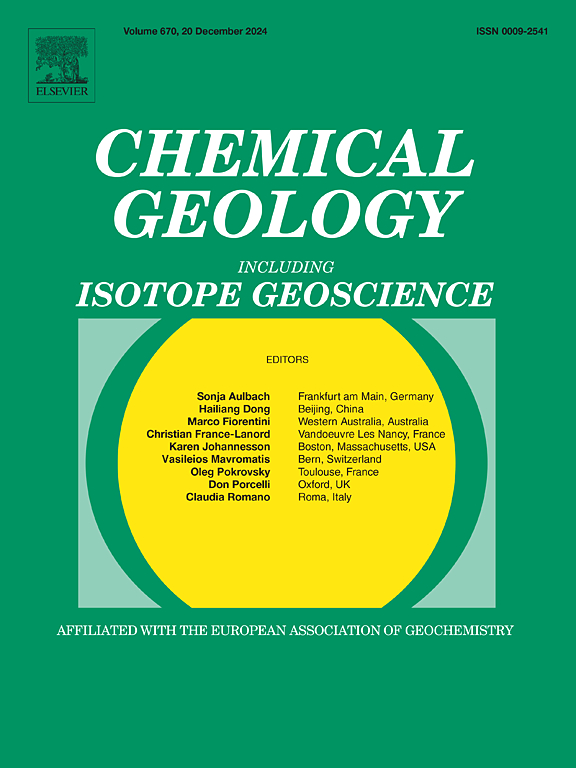铬尖晶石中关键成岩微量元素的精确电子探针微量分析
IF 3.6
2区 地球科学
Q1 GEOCHEMISTRY & GEOPHYSICS
引用次数: 0
摘要
铬尖晶石的微量元素组成对解释一大批基性-超基性岩石的岩石成因具有重要意义。虽然激光烧蚀电感耦合等离子体质谱(LA-ICP-MS)已被证明对测定cr尖晶石的微量元素丰度非常有用,但表征在微米长度尺度上不均匀的cr尖晶石晶粒需要使用比LA-ICP-MS提供更好空间分辨率的技术。在这项工作中,我们利用制造商提供的软件开发了一种电子探针微量分析(EPMA)测定cr尖晶石中痕量元素和微量元素的方案。优化的分析条件(25 kV加速电压,900 nA束流,60-480 s峰值计数次数,综合谱仪数据)使我们能够在4-26 ppm范围内实现检测限(3σ),相对分析精度(2σ)在1 - 3%范围内(Ti, V, Mn, Co, Ni和Zn),除了Sc和Ga,它们的精度要低得多(36 - 46%)。所开发的方法应用于Mayarí-Baracoa蛇绿岩带(古巴东部)的cr尖晶石颗粒分析,与先前用于评估EPMA结果可靠性的LA-ICP-MS分析相一致。对于Ti、V、Mn、Co、Ni和Zn, EPMA和LA-ICP-MS数据的均方根百分比偏差(RMS)在4.7% ~ 22.5%之间,而对于Ga,均方根百分比偏差为32.5%。Sc的均方根值要高得多(171%),尽管该元素的检出限很低(4 ppm)。结果表明,EPMA法测得的原生cr尖晶石微量元素组成除Sc外,可作为铬铁矿成因信息的可靠依据。本文章由计算机程序翻译,如有差异,请以英文原文为准。
Accurate electron probe microanalysis of key petrogenetic minor and trace elements in Cr-spinel
The trace element composition of Cr-spinel is paramount for interpreting the petrogenesis of a large group of mafic to ultramafic rocks. Although laser ablation inductively coupled plasma mass spectrometry (LA-ICP-MS) has proven to be very useful for the determination of trace element abundances of Cr-spinel, the characterization of Cr-spinel grains that are inhomogeneous over micrometer length scales requires the use of techniques that provide a better spatial resolution than LA-ICP-MS. In this work, we develop a protocol for the determination of trace and minor elements in Cr-spinel by electron probe microanalysis (EPMA) using the software provided by the manufacturer. The optimized analytical conditions (25 kV accelerating voltage, 900 nA beam current, 60–480 s peak counting times, aggregate spectrometer data) allowed us to achieve detection limits (3) in the range 4–26 ppm with relative analytical precisions (2) in the range 1–3 % for all analyzed elements (Ti, V, Mn, Co, Ni, and Zn), except for Sc and Ga, for which the precision was much lower (36–46 %). The developed methodology was applied to the analysis of Cr-spinel grains from the Mayarí-Baracoa Ophiolitic Belt (eastern Cuba), in correspondence with previous LA-ICP-MS analyses, which were used to assess the reliability of the EPMA results. The root mean square percentage deviation (RMS) between the EPMA and LA-ICP-MS data was in the range 4.7–22.5 % for Ti, V, Mn, Co, Ni, and Zn, while for Ga the RMS value was 32.5 %. For Sc, the RMS value was much higher (171 %), despite the low detection limit achieved (4 ppm) for this element. Our results indicate that the trace element composition of primary Cr-spinel obtained by EPMA can be readily used, except for Sc, to constrain petrogenetic information on chromitites in a reliable way.
求助全文
通过发布文献求助,成功后即可免费获取论文全文。
去求助
来源期刊

Chemical Geology
地学-地球化学与地球物理
CiteScore
7.20
自引率
10.30%
发文量
374
审稿时长
3.6 months
期刊介绍:
Chemical Geology is an international journal that publishes original research papers on isotopic and elemental geochemistry, geochronology and cosmochemistry.
The Journal focuses on chemical processes in igneous, metamorphic, and sedimentary petrology, low- and high-temperature aqueous solutions, biogeochemistry, the environment and cosmochemistry.
Papers that are field, experimentally, or computationally based are appropriate if they are of broad international interest. The Journal generally does not publish papers that are primarily of regional or local interest, or which are primarily focused on remediation and applied geochemistry.
The Journal also welcomes innovative papers dealing with significant analytical advances that are of wide interest in the community and extend significantly beyond the scope of what would be included in the methods section of a standard research paper.
 求助内容:
求助内容: 应助结果提醒方式:
应助结果提醒方式:


